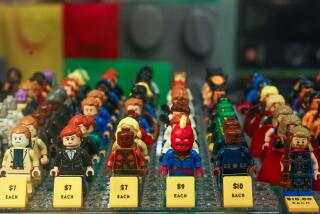Superpowers get flexed at auction
- Share via
For decades, comic-book depictions of Batman, Spider-Man and other spandex-clad superheroes have been dismissed by art aficionados as mere lowbrow “funny book” art, the domain of geeky enthusiasts. But in a revenge-of-the-nerds turnabout, serious collectors of art from the superhero subgenre are having the last laugh -- all the way to the bank.
Not only is “Fantastic Four” and “X-Men” co-creator Jack Kirby represented in the “Masters of American Comics” exhibition at the UCLA Hammer Museum and Museum of Contemporary Art (through March 12), but the originals for pages and covers featuring superheroes have begun to garner fine-art prices. The reason? Nostalgia-minded collectors seeking to reclaim their personal Rosebuds.
In August, the hand-drawn 1942 cover art for “Batman” No. 11 sold at auction at Dallas-based Heritage Comics for $195,500. According to Sotheby’s comic art consultant Jerry Weist, the “Batman” cover price set a record, blowing away the previous auction high for a single piece of superhero art, set three years ago by a 1930s “Superman” daily strip. That one was sold by Sotheby’s through EBay for $115,000.
Splashy as these auction sales are, they represent just the tip of the iceberg in a field where the real action, collectors and market watchers say, takes place behind the scenes.
Many sellers avoid auctions because of seller fees, which may be as much as 15% of the hammer price. In addition, “a piece of art that doesn’t meet reserve [the minimum bid] often becomes tainted and difficult to sell,” says Mitch Itkowitz, a comics art dealer in Saugerties, N.Y. As a result, he says, most sales tend to take place in private transactions between collectors and dealers at comic-book conventions or via the Internet.
In September, for example, dealer Spencer Beck of East Norwalk, Conn., brokered a sale of the 1971 cover art for “The Amazing Spider-Man” No. 100, by John Romita Sr., one of the better known Spider-Man artists, for slightly less than $60,000. A month earlier, Romita Sr.’s cover for “The Amazing Spider-Man” No. 41 sold for $58,650 at Heritage.
“There’s always that piece that people have to have, and they’ll pay for it,” says John Dolmayan, 33, drummer for System of a Down and a superhero art collector. “It’s not like they’re making these pages again -- there’s only one original.”
In addition to the big-ticket items -- such as the “Batman” and “Spider-Man” covers -- sales of superhero art for $10,000 to $15,000 have become commonplace. A quick search through ComicArtFans.com’s website, where more than 3,000 collectors show off highlights from their collections, finds dozens of pages and covers for sale in that range, including pieces by John Byrne (“The Uncanny X-Men”), Neal Adams (“Batman”), Jim Lee (“Superman”) and Steve Ditko (“The Amazing Spider-Man”).
“What’s happening is people who had their imaginations sparked by comics as kids have grown up and now have money to spend,” says Weist, who wrote “The Comic Art Price Guide.” “Now those people are looking to buy artwork from those same comics, and as a result, comic art has become one of the blue-chip collectibles.”
In the last 15 years, Weist says, these passionate, sometimes obsessive collectors in their 30s and 40s have driven up the price for prime pieces of superhero art by as much as 20 times.
David Mandel, 35, is one such collector. He began acquiring superhero art 10 years ago when he was a writer on “Seinfeld.” Now the walls of his Los Angeles home, a Louvre of superhero art, are covered with originals from comics he remembers fondly from youth. Among the notables: Michael Zeck’s cover to “Punisher” No. 1, Kirby’s “Fantastic Four” No. 59 cover and Frank Miller’s cover for “Daredevil” No. 181, which portends the death of Elektra as portrayed in the 2003 “Daredevil” feature film.
Mandel’s pride and joy are two “Amazing Spider-Man” covers drawn by Spider-Man co-creator Ditko in the 1960s, one of which includes an appearance by one of the Wall-Crawler’s oldest villains, Doctor Octopus. Mandel says he paid $100,000 to $200,000 total (he wouldn’t give an exact figure) for the two covers -- many collectors would say he got a bargain -- but added that most of his collection was purchased for a fraction of its current value.
“Some of it has gone up in value a lot, and that’s a very nice thing,” says Mandel, who wrote the “Seinfeld” episode titled “Bizarro Jerry,” a take on “Bizarro Superman.” “At the same time, I can honestly say that every piece I ever bought was with the intent of keeping it, putting it on the wall -- and not to make a profit.”
Another collector who got into the game early is Mike Burkey, a radiation therapist in Cleveland. In the late 1980s, Burkey, now 40, began buying “Spider-Man” pages drawn by Romita Sr. for $40 apiece from dealers, collectors and Marvel Comics artists. His passion drove him to pay more and more, what’s sometimes known as “stupid money.”
“I remember in 1993 a guy in New York wanted $2,000 for four Romita Sr. ‘Amazing Spider-Man’ pages from issue No. 50, and at the time no single page had sold for more than $300,” says Burkey, who has adopted the moniker “Romitaman.” “My friends say, ‘Don’t do it, you’re an idiot.’ I said, ‘I know they’re overpriced, but one day they’re going to be considered cheap,’ and so I bought the pages.”
Itkowitz, who in the last 25 years has sold hundreds of Romita Sr. “Spider-Man” pages, estimates that those pages would now sell for $5,000 to $7,000 each.
Some collectors complain that rising prices are the result of the large numbers of originals in the hands of a few people. Burkey, for example, has more than 1,000 Romita Sr.-drawn “Amazing Spider-Man” originals. He makes no apologies, however, and he notes that rising prices cut both ways: He was the buyer of the “Amazing Spider-Man” No. 100 cover.
Burkey, Dolmayan and other collectors say they’re often loath to sell pieces because they can have even more value as bartering chips. This year, Burkey was able to pry a piece from a fellow collector by trading a group of Romita Sr. and Ditko works for it. As a result, he owns his Holy Grail, the page from “Amazing Spider-Man” No. 42 in which Peter Parker answers the door and Mary Jane Watson introduces herself with what may be comic books’ most memorable line: “Face it, Tiger ... you just hit the jackpot!”
Mandel shuns terms like “stupid money.” “My mother would argue it’s all stupid money. I don’t care if people call it ‘stupid money.’ If you have to have a piece, it’s just not stupid.”
Mandel paid what some collectors might call stupid money: $37,375 for the “X-Men” No. 138 cover at auction in October at Heritage.
By most criteria, the cover, drawn by fan favorite Byrne in 1980, is far from aesthetically pleasing. It features X-Men team leader Cyclops in a less than dynamic pose, the background as it appears in the printed comic is missing. And its re-created logo sticks out like a sore thumb. But don’t tell that to Mandel.
“My attraction to the cover is purely nostalgic, and as a result I love how it looks, warts and all,” he says. “To me it’s pretty because it’s the first issue of the ‘X-Men’ I ever read.”
To pay for it, he’s thinking about selling another cover, “and some might say that that piece is prettier, but that’s what collecting comic art is all about.”
More to Read
The biggest entertainment stories
Get our big stories about Hollywood, film, television, music, arts, culture and more right in your inbox as soon as they publish.
You may occasionally receive promotional content from the Los Angeles Times.










